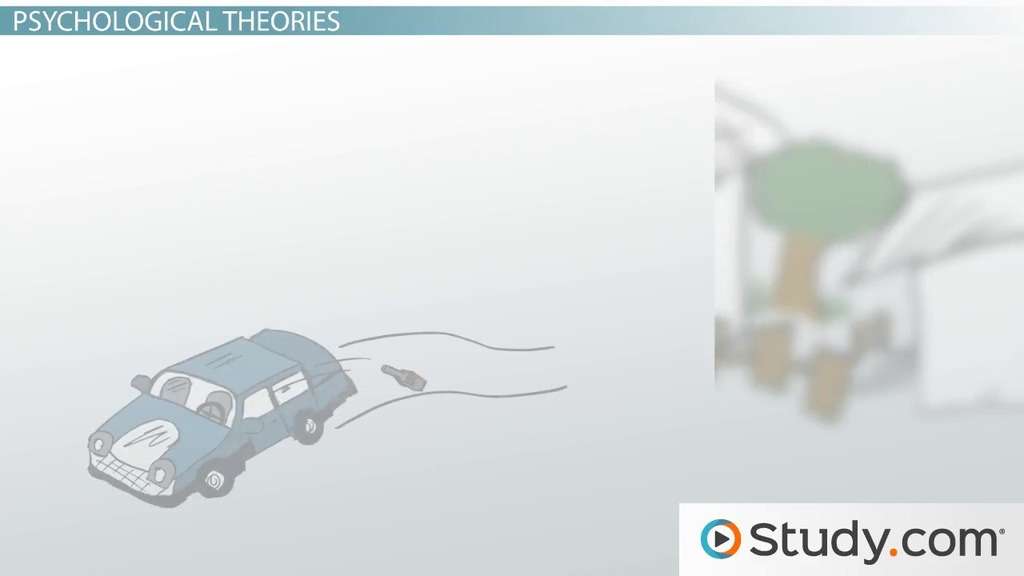Psychological Theories
When Amy goes to visit Rory, she’s reminded of all the differences between them. He’s in jail for a violent crime and doesn’t even feel sorry. It’s like he doesn’t really understand that what he did was wrong.
Psychological theories of crime say that criminal behavior is a result of individual differences in thinking processes. There are many different psychological theories, but they all believe that it is the person’s thoughts and feelings that dictate their actions. As such, problems in thinking can lead to criminal behavior. Take Rory, for example, he doesn’t believe that what he did was wrong, which was what led him to act out in the first place.
There are four basic ideas when it comes to psychological theories of crime. These general assumptions are that crime is a result of:
1. Failures in psychological development
Some people run into trouble because they didn’t develop, or grow, the way that others normally do. For example, Rory has an underdeveloped conscience. Whereas Amy hears a little voice inside her reminding her what is right and wrong, Rory just does what he wants and doesn’t think about right or wrong. This is an example of what happens when someone has an issue with psychological development.
2. Learned behaviors of aggression and violence
If someone is surrounded by violence and aggression, they are more likely to become violent and aggressive themselves, because they have learned that those behaviors are okay. For example, Rory comes from a very abusive household, and his violent parents taught him that it’s normal to work out your frustrations by being violent against others.
3. Inherent personality traits
There are some characteristics that criminals tend to share with each other, and some psychologists believe that there are certain personality traits that predispose someone towards criminal behavior. For example, even as a baby, Rory liked to seek out dangerous and exciting activities. Amy is happy to stay at home with a book; that’s enough excitement for her. But, Rory likes danger, which could lead him to act recklessly and perhaps in criminal ways.
4. Relationship of criminality to mental illness
Some people with psychological disorders end up committing crimes. While this isn’t the case for all people with mental illness, there is a higher-than-normal percentage of criminals with mental illness. For example, Rory has been diagnosed with a personality disorder, which means that he feels less empathy than other people.
All of these psychological factors could have an effect on someone like Rory, who then ends up a criminal.
Criticisms
Amy is wondering if psychological theories of crime could explain why her friend Rory ended up a criminal, whereas she ended up a law-abiding citizen. There certainly seems to be a lot of psychological differences between the two of them. Could that explain the differences in their behavior?
Though there is much support for psychological theories, there are also some criticisms. For one thing, opponents point out that psychological theories can’t explain why some people are criminals and others aren’t. For example, not everyone with mental illness ends up a criminal, and not everyone who was abused ends up a criminal. But, Rory, who was abused and has a psychological disorder, ended up a criminal. Psychological theories can’t tell us why that is true.
Another issue with psychological theories of crime is that they are difficult to test. Amy can’t open up Rory’s head and see his psychological issues carved on his brain. All a person can see are the symptoms of a psychological problem, not the underlying issue. This could lead to misdiagnoses and even lead to some people faking psychological disorders in order to get a lighter sentence.
Finally, treatment plans based on psychological theories are not always effective. There is still a high rate of criminals who commit crimes even after being treated for psychological issues. Thus, even though psychological theories might be correct in judging why people become criminals, they haven’t yet figured out how to prevent people from becoming or continuing to be criminals.
Lesson Summary
Criminology is the study of crime and punishment. Psychological theories of crime look at how differences in people’s thoughts and feelings can lead to criminal behavior. There are four basic aspects of psychological theories of crime, which say that crime is a result of failures in psychological development, learned behaviors of aggression and violence, inherent personality traits, and the relationship of criminality to mental illness. Though there is a lot of support for psychological theories of crime, there are also some criticisms, including the idea that they can’t explain why some people are criminals and others aren’t, even when they have the same issues; they are difficult to test; and that treatment plans based on psychological theories are not always effective.
Learning Outcomes
When you finish watching the video, you should understand how to:
- Recall the definition of criminology
- List the four basic psychological theories of crime
- Discuss the criticisms of the psychological theories of crime
Those who enter the criminal justice field quickly learn that understanding criminology theories for why people turn to crime is key to reducing crime rates and making society safer. After three decades of research, three major psychological theories of time have emerged: psychodynamic theory, behavioral theory and cognitive theory.
Learning these criminology theories and how to put them into practice is a component of an online Bachelor of Science in Criminal Justice degree program. For many students, understanding why people commit crimes is one of the major reasons they want to enter the criminal justice field.
What Influences Behavior in Criminals?
The three major criminal theories have emerged after decades of research on the criminal mind. The psychodynamic theory centers on a person’s early childhood experience and how it influences the likelihood for committing crime. Behavioral theory focuses on how perception of the world influences behavior. And cognitive theory focuses on how people manifest their perceptions can lead to a life of crime.
Psychodynamic Theory
This theory largely comes to us from the mind of noted psychologist Sigmund Freud. He argued that everyone has instinctual drives (called the “id”) that demand gratification. Moral and ethical codes (called the “superego”) regulate these drives, and adults later develop a rational personality (called the “ego”) that mediates between the id and superego. Based on this idea, criminal behavior is seen primarily as a failure of the superego.
More generally, psychodynamic theory sees criminal behavior as a conflict between the id, ego and superego. This conflict can lead to people developing problematic behavior and delinquency. The challenge with this theory is it is difficult to test.
Behavioral Theory
This theory revolves around the idea that human behavior develops through experience. Specifically, behavioral theory focuses on the idea that people develop their behavior based on the reaction their behavior gets from those around them. This is a form of conditioning, where behavior is learned and reinforced by rewards or punishment.
So, if a person is in the company of those who condone and even reward criminal behavior – especially a figure of authority – then they will continue to engage in that behavior. For example, social learning theorist Albert Bandura maintains individuals are not born with an innate ability to act violently. He instead suggests people learn violent behavior through observing others. Typically, this comes from three sources: family, environmental experiences and the mass media.
Cognitive Theory
Cognitive theory focuses on how people perceive the world and how this perception governs their actions, thoughts and emotions. Most cognitive theorists break down the process into three levels of what is called “moral development.”
-
Pre-conventional level
. This involves children and how they learn the external consequences of their actions.
-
Conventional level
. This involves teens and young adults, who begin to base behavior on society’s views and expectations.
-
Post-conventional level
. In those over the age of 20, the focus is more on judging the moral worth of societal values and rules and how they relate to values of liberty, human welfare and human rights
In the area of crime, cognitive theorists argue that criminals do not develop moral judgment beyond a pre-conventional level.
All three of these criminology theories undergo constant scrutiny and revision, but they provide the foundations upon which current ideas are based. These theories are one of the most interesting aspects of criminology learned by those who enter a criminal justice degree program.
When examining psychological theories of crime, one must be cognizant of the three major theories. The first is psychodynamic theory, which is centered on the notion that an individual’s early childhood experience influences his or her likelihood for committing future crimes. The second is behavioral theory. Behavioral theorists have expanded the work of Gabriel Tarde through behavior modeling and social learning. The third is cognitive theory, the major premise of which suggests that an individual’s perception and how it is manifested (Jacoby, 2004) affect his or her potential to commit crime.
Outline
1. Introduction
Why do individuals commit crimes? At the same time, why is crime present in our society? The criminal justice system is very concerned with these questions, and criminologists are attempting to answer them. In actuality, the question of why crime is committed is very difficult to answer. However, for centuries, people have been searching for answers (Jacoby, 2004). It is important to recognize that there are many different explanations as to why individuals commit crime (Conklin, 2007). One of the main explanations is based on psychological theories, which focus on the association among intelligence, personality, learning, and criminal behavior. Thus, in any discussion concerning crime causation, one must contemplate psychological theories.
When examining psychological theories of crime, one must be cognizant of the three major theories. The first is psychodynamic theory, which is centered on the notion that an individual’s early childhood experience influences his or her likelihood for committing future crimes. The second is behavioral theory. Behavioral theorists have expanded the work of Gabriel Tarde through behavior modeling and social learning. The third is cognitive theory, the major premise of which suggests that an individual’s perception and how it is manifested (Jacoby, 2004) affect his or her potential to commit crime. In other words, behavioral theory focuses on how an individual’s perception of the world influences his or her behavior.
Also germane to psychological theories are personality and intelligence. Combined, these five theories or characteristics (i.e., psychodynamic, cognitive, behavioral, personality, and intelligence) offer appealing insights into why an individual may commit a crime (Schmalleger, 2008). However, one should not assume this there is only one reason why a person commits crime. Researchers looking for a single explanation should be cautious, because there is no panacea for the problem of crime.
2. Early Research
Charles Goring (1870–1919) discovered a relationship between crime and flawed intelligence. Goring examined more than 3,000 convicts in England. It is important to note that Goring found no physical differences between noncriminals and criminals; however, he did find that criminals are more likely to be insane, to be unintelligent, and to exhibit poor social behavior. A second pioneer is Gabriel Tarde (1843–1904), who maintained that individuals learn from each other and ultimately imitate one another. Interestingly, Tarde thought that out of 100 individuals, only 1 was creative or inventive and the remainder were prone to imitation (Jacoby, 2004).
3. Psychodynamic Theory
Proponents of psychodynamic theory suggest that an individual’s personality is controlled by unconscious mental processes that are grounded in early childhood. This theory was originated by Sigmund Freud (1856–1939), the founder of psychoanalysis. Imperative to this theory are the three elements or structures that make up the human personality: (1) the id, (2), the ego, and (3) the superego. One can think of the id is as the primitive part of a person’s mental makeup that is present at birth. Freud (1933) believed the id represents the uncons cious biological drives for food, sex, and other necessities over the life span. Most important is the idea that the id is concerned with instant pleasure or gratification while disregarding concern for others. This is known as the pleasure principle, and it is often paramount when discussing criminal behavior. All too often, one sees news stories and studies about criminal offenders who have no concern for anyone but themselves. Is it possiblethat these male and female offenders are driven by instant gratification? The second element of the human personality is the ego, which is thought to develop early in a person’s life. For example, when children learn that their wishes cannot be gratified instantaneously, they often throw a tantrum. Freud (1933) suggested that the ego compensates for the demands of the id by guiding an individual’s actions or behaviors to keep him or her within the boundaries of society. The ego is guided by the reality principle. The third element of personality, the superego, develops as a person incorporates the moral standards and values of the community; parents; and significant others, such as friends and clergy members. The focus of the superego is morality. The superego serves to pass judgment on the behavior and actions of individuals (Freud, 1933). The ego mediates between the id’s desire for instant gratification and the strict morality of the superego. One can assume that young adults as well as adults understand right from wrong. However, when a crime is committed, advocates of psychodynamic theory would suggest that an individual committed a crime because he or she has an underdeveloped superego.
cious biological drives for food, sex, and other necessities over the life span. Most important is the idea that the id is concerned with instant pleasure or gratification while disregarding concern for others. This is known as the pleasure principle, and it is often paramount when discussing criminal behavior. All too often, one sees news stories and studies about criminal offenders who have no concern for anyone but themselves. Is it possiblethat these male and female offenders are driven by instant gratification? The second element of the human personality is the ego, which is thought to develop early in a person’s life. For example, when children learn that their wishes cannot be gratified instantaneously, they often throw a tantrum. Freud (1933) suggested that the ego compensates for the demands of the id by guiding an individual’s actions or behaviors to keep him or her within the boundaries of society. The ego is guided by the reality principle. The third element of personality, the superego, develops as a person incorporates the moral standards and values of the community; parents; and significant others, such as friends and clergy members. The focus of the superego is morality. The superego serves to pass judgment on the behavior and actions of individuals (Freud, 1933). The ego mediates between the id’s desire for instant gratification and the strict morality of the superego. One can assume that young adults as well as adults understand right from wrong. However, when a crime is committed, advocates of psychodynamic theory would suggest that an individual committed a crime because he or she has an underdeveloped superego.
In sum, psychodynamic theory suggests that criminal offenders are frustrated and aggravated. They are constantly drawn to past events that occurred in their early childhood. Because of a negligent, unhappy, or miserable childhood, which is most often characterized by a lack of love and/or nurturing, a criminal offender has a weak (or absent) ego. Most important, research suggests that having a weak ego is linked with poor or absence of social etiquette, immaturity, and dependence on others. Research further suggests that individuals with weak egos may be more likely to engage in drug abuse.
1
2 3 4 5 6 7
Pages:




